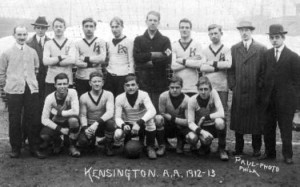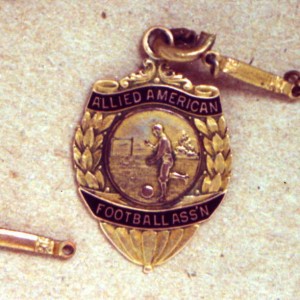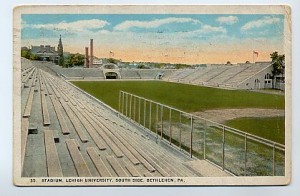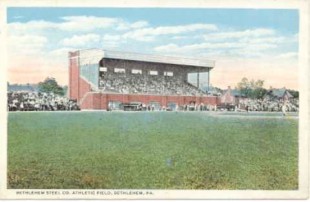The the story of Bethlehem Steel FC goes something like this:
In 1904, a soccer ball was brought to Bethlehem from Scotland. The ball created “quite a lot of excitement among the athletically inclined” residents of the growing steel town and soon games were being played with a team from nearby Allentown. By 1912 the team, playing as Bethlehem FC, was competing in the Philadelphia-based Allied American Football Association League, winning the league championship each of the three seasons they were in the league. In 1914 they won their first of six American Football Association American Cup titles. They won the National Challenge Cup, as the US Open Cup was originally known, for the first time in 1915 and would win it four more times by 1926. In 1916 they began playing home games at Bethlehem Steel Athletic Field, the first soccer field in the US with stadium seating.
The team went professional in 1914 as Bethlehem Steel FC with the backing of the giant steel company. As a professional team, Bethlehem Steel FC would win six league championships, three with the National Association Foot Ball League, one with the American Soccer League and two with the Eastern Soccer League. Playing as the Philadelphia Field club in the 1921-1922 season, they won another ASL championship. As a professional team they finished second in various leagues five times. Along the way they became the first US professional soccer team to tour in Europe.
After 1930, they were gone.
Getting started
After a few years of more or less informally organized matches against local opposition, Bethlehem FC figured it was time to test itself against some serious opposition. Setting a high bar, they traveled to Harrison, New Jersey to play West Hudson, possibly the best team in the country, on November 17, 1907. Bethlehem lost that game 11–2. When the teams met again a few weeks later, Bethlehem lost 9–0.
An article from the October 16, 1908 edition of the Philadelphia Inquirer describes Bethlehem’s return to playing local teams. Facing teams from Reading, Boyer Heights, Harrisburg, Lancaster and Lansford, Bethlehem also began to arrange matches with teams from the Philadelphia League. The article describes Bethlehem FC as “formed from the Scotchmen, Englishmen and Welshmen employed hereabouts, some of whom were stars in the old country.” On March 27, 1909, Philadelphia’s Tacony lost to Bethlehem away 2–0. It would be one of the few losses suffered by Tacony on their way to a league and American Cup championship in 1910. In August of 1911, Bethlehem joined the newly formed Eastern Pennsylvania League, composed of teams from Reading, Harrisburg, Lancaster, Lansford and Summit Hill.
Moving into the Philadelphia leagues
An article in the February 9, 1912 edition of the Philadelphia Inquirer reports that Bethlehem had joined the roster of “associated members” of the Philadelphia-based Allied Amateur Football Association for participation in the Allied Cup competition. Twenty-six clubs would feature in the knockout tournament, “the largest of its kind that has ever been scheduled before in this part of the country.”
Bethlehem continued to schedule exhibition games with Philadelphia-area clubs, including one to be played against Haverford College “on the football gridiron at Lehigh University.” An article from the February 16, 1912 edition of the Philadelphia Inquirer reported that the match was cancelled because “the Lehigh athletic management has flooded the football field and turned it into a first class skating rink, where students play hockey, and because of this fact the field will not be available for soccer for several weeks yet.” A few days later Bethlehem defeated the Boys’ Club of Philadelphia, “Champions of the Interstate Soccer League,” 5–1.
Bethlehem advanced to the final of the Allied Amateur Cup competition to face Cardington, champion of the Philadelphia and Suburban League, on May 4, 1912 at Washington Park at 26th and Allegheny Avenue. The first half belonged to the Delaware County team, who scored two goals in the first thirteen minutes of play and a third just before the half. Bethlehem fought back to score two goals in the second half but it was not enough. With the final score of 3–1, AAFA officials “presented the cup and championship cups to the winners and silver watch fobs to the losers.” It was Bethlehem’s only loss of the season.
At “an enthusiastic meeting” in August of 1912, Bethlehem formally applied for membership in the Allied American League of Philadelphia with the aim to “make greater strides the coming season if possible.”
Making their mark in Philadelphia

The Kensington team, a fellow innaugural member of the Allied American Football Association first division
The beginning of the 1912 season saw the increasing popularity of soccer in Philadelphia. An article in the September 29 edition of the Philadelphia Inquirer described seven leagues operating in the city. These included the semi-professional Pennsylvania League—home of such notable Philadelphia teams as Tacony and Hibernian—the league causing a stir among local soccer fans when it raised the price of admission to matches from 15¢ to 25¢; the Allied American Football Association league with three divisions of ten teams each and made up of teams from the earlier Allied League, Inter-State League, Philadelphia and Suburban League and St. George’s League; and the Associated Cricket League with two divisions each with six teams. The article noted that, “Counting all the league and independent teams in this vicinity there are nearly twice the number of clubs of any other city in the East without taking into account the Grammar School leagues, which will be organized later in the season.” In January of 1913, the United League joined the list of Philadelphia leagues, described in the January 20, 1913 edition of the Inquirer as made up of “Twelve of the strongest independent clubs in this city and vicinity, composed of young players.”
Bethlehem dominated the first division of the Allied American League. When the Peabody team arrived late in Bethlehem on November 23 because they had missed their train, the match was played over two 20 minute halves due to darkness. Bethlehem won 5–0. A few days later, Bethlehem defeated West Philadelphia 7–0. By the beginning of December, the Bethlehem had won eight out of eight games played with only Cardington close behind with one loss. The Philadelphia inquirer reported on December 2, “Bethlehem should cop the Allied League first division with lots to spare, for there appears none of the teams able to hold them since the steelworkers included some of last year’s Pennsylvania League stars in their ranks.” Bethlehem solidified their lead over Cardington—and avenged their loss to them in the Allied Amateur Cup competition—with a 2–0 win on December 7.
The team’s unbeaten streak continued through February when it suffered its first loss in 16 games in a shocking upset to Allied American League second division side Tacony (not the same team as the Tacony team, later renamed Disston, in the semi-professional Pennsylvania League) in the first round of the league’s cup competition. The February 9, 1913 edition of the Inquirer reported, “Without making any excuses, the local team came on the field minus Captain Galbraith and Lawler, two of their best players, and then played most of the game with ten men after Peacock was hurt.” The final score was 4–1.

The watch fob awarded to Bethlehem FC players for winning the 1913 Allied American League first division title.
A week later, Bethlehem clinched the league championship when they defeated Cardington 6–1. They would finish the season with seventeen wins, dropping their last game to West Philadelphia.
A two-game series to decide the amateur champion of the state of Pennsylvania was organized by Bethlehem and Boys’ Club, themselves top of the table in the Philadelphia’s American League. The March 2 edition of the Philadelphia Inquirer noted, “The respective teams are considered the peer of the amateurs in this State, and there is every indication that the series will be closely contested.”
Bethlehem warmed up for the series by defeating the University of Pennsylvania squad 3–1 on March 8 ahead of the first home leg of the championship series. When Boys’ Club came to Bethlehem on March 22, Bethlehem was first on the board after scoring a penalty kick. Boys’ Club quickly responded to equalize. The visitors then took the lead on a penalty kick of their own and the half ended with Boys’ Club leading 2–1 despite Bethlehem having, the Philadelphia Inquirer reported on March 23, “no less than a dozen tries” on goal. With Bethlehem seeming to have “shot its bolt,” Boys’ Club held on for the road win.
The second leg of the championship series was played April 5 at Front and Erie Avenue. The Inquirer match report states that, “Right from the start with a strong wind against them, Boys’ Club played like a beaten team” and Bethlehem won the match 2–0. “While it was expected that the game would prove one of the best of the season with so much at stake, and also on account of the reputation of the two teams, it did not come up to expectations, there being entirely too much roughness infused into the game and the scientific end of the contest suffered in consequence.”
Bethlehem’s outside left Fleming—described in the April 7 edition of the Philadelphia Inquirer as “one of the best outside lefts in the country and shoots with the force of a forty-eight caliber Colt”—scored both goals for the visitors. After a collision with Boys’ Club left halfback Gilmore, Fleming entertained the crowd with more than his goal scoring, creating “lots of amusement among the spectators by limping around the field. The match report continued, “it looked as if he were injured seriously, but everytime the ball came his way he must have forgotten his injury, for he sprinted and dribbled the ball as if nothing were the matter with him.” Meanwhile, Gilmore had fractured his leg in two places and Boys’ Club finished the match with ten men.
The Philadelphia Inquirer match report says that a final deciding match would be played on April 19, 1913. Unfortunately, I can find no records indicating whether that game was played or, if it was, what the score would be. But, no matter. For Bethlehem Steel, bigger things were ahead.
All images courtesy of http://bethlehemsteelsoccer.org/



You are the MAN! I love these posts on the history of the beautiful game in the States.
Thanks man! I love learning about Philly’s soccer history and am very happy others like learning about it too. Thanks for reading!
keep ’em coming. these are great. unrelated to this post but i got to meet a player for one of the philadelphia unkranians championships squads while playing at a tournament in buenos aires. it was incredible. he brought out a scap book with pictures from the whole season and newspaper clippings. piqued my interest hardcore for philly soccer history.
i might have already shared that but damn it was cool. ha.
That is totally cool! Was it Alex Ely?
it wasn’t alex ely. damn i’m having trouble remembering the guys name. he seemed very ukranian, was living in argentina, and was pretty old. my mind was a flutter of days of multiple games per day, trying to communicate with my limited grasp of italian/spanish/german, and being out of the country though. i’ll ask some of my teammates and try to figure it out.
Duh, what am I thinking. Alex Ely has a Brazilian background, not Argentinian. (I always get Buenos Aires and Rio De Janeiro mixed up.)
John (Ivan) Borodiak was born in Buenos Aires, his parents were Ukrainian. Played for the Ukes in the 1960’s.
hello,was there an award for the 1915-1916 Bethlehem Steel Company F.C.
American League 1915-1916?